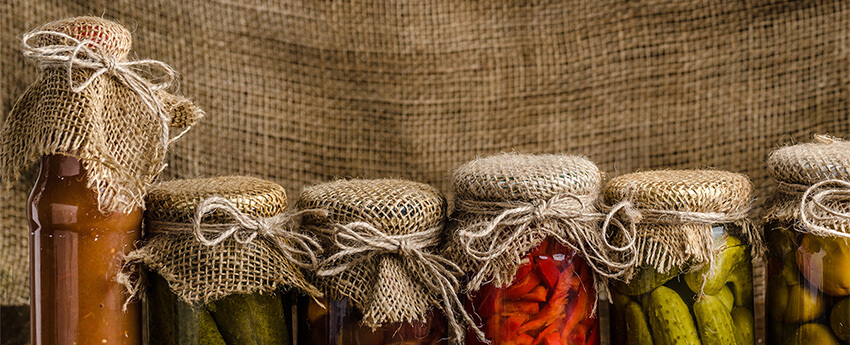
Among the various methods under Food Processing which are being reckoned from Refrigeration and freezing, Canning, Irradiation, Dehydration, Freeze-drying, Pasteurizing and Fermentation – we have one common used process in food preservation which of course treats and handles food in such a way as to impede or intensely slows down spoilage to avoid foodborne diseases and lengthens its shelf-life as well and that’s Pickling!
Pickling is one of those mystic methods of Food Processing techniques that not only lengthens a food’s shelf life, but also seizes its savory profile to fascinating and delightful distances. If it suits into a jar, then it’s undoubtedly match for pickling. From the basic pickled garlic to sweet pickled daikon radish, there is something you ought to have for every time of the season.
Pickling is actually a special solution made from vinegar, brine, ethanol, and with other types of oil which is also used to treat and sustain certain kinds of meat, vegetables and fruits. The food can be prepared with the solution and then stored in a jar then left to pickle. As a matter of choice, the other fresh food components or ingredients could also be gathered in a jar and then filled with the solution to pickle.
Take a little bit of time today and mean some bright and fresh pickles six months down the road. It’s high pickling and preservation season, so pull out those mason jars and start to work! We may have several of pickling recipes but check out the few of the many recipes below.
GARLIC DILL PICKLES RECIPE
INGREDIENTS
- 2 quarts of cucumbers (roughly 3 pounds)
- 1 1/2 cups apple cider vinegar
- 1 1/2 cups filtered water
- 2 tablespoons pickling salt
- 8 garlic cloves, remove skin or peel
- 4 teaspoons dill seed
- 2 teaspoons black peppercorns
- 1 teaspoon red chili flakes
PROCEDURE
- Wash your jars sensibly in warm, soapy water. If you plan on making shelf stable pickles, prepare a boiling water bath canner. Place fresh canning jar lids into a small pan with 3 inches of water and set to the barest simmer.
- Wash and dry cucumbers. Remove blossom end. Cut it into chips, spears or leave whole, depending on your preference of course.
- Incorporate vinegar, water and salt in a pan and bring to a boil.
- In the same way divide garlic cloves equally, dill seed, black peppercorns and red chili flakes between jars. Pack primed cucumbers into jars as tightly as you can without crushing them.
- Transfer or put the brine into the jars, leaving 1/4 inch headspace.
- Remove and take out any air bubbles from jars by moderately tapping them. You can as well use a wooden chopstick or plastic utensil to help eradicate stubborn bubbles.
- Wipe its rims and put on lids and bands.
- If handling jars for shelf constancy, lower jars into your processing pot. When water returns to a boil, set your timer for 10 minutes.
- When time is up, remove the jars from canning pot and allow them to cool down. If you already satisfied with jar’s temperature and good to handle, the next thing to do is to check the seals.
- If you choose not to process your jars, let them cool before putting them into the refrigerator. Do keep in mind that your jars may be sealed during the cooling process. However, without letting the boiling water bath process happen, shelf life will be unstable but still refrigerate them.
- Let pickles rest for at least one week before eating.
PICKLED RED GRAPES
INGREDIENTS
- 1 pound red grapes
- 1 cup apple cider vinegar
- 1 cup granulated white sugar
- 1/4 cup water
- 1 cinnamon stick
- 1/2 vanilla bean
- 1/4 teaspoon cloves
- 1/4 teaspoon black peppercorns
- 1/8 teaspoon yellow mustard seeds
PROCEDURE
- Wash the grapes and remove them from stem.
- Cut stem end off of the grapes and put them aside.
- In a small pan, mix vinegar, water and sugar. Place over high heat and bring to a boil.
- Put on spices into the bottom of a quart jar.
- Funnel trimmed grapes into the jar on top of the spices.
- Pour hot vinegar into jar over grapes.
- Let grapes sit until they are cool down. Put on the lid on the jar and refrigerate them.
- Let pickled grapes rest in the fridge for at least 24 hours before serving.
MARINATED FAVA BEANS
INGREDIENTS
- 1 1/2 pounds fava beans
- 2 tablespoons sherry or red wine vinegar
- 2 tablespoons olive oil
- 1 medium garlic clove, finely minced
- 2 sprigs fresh rosemary
- 1/2 teaspoon salt
- 1/4 teaspoon freshly ground black pepper
PROCEDURE
- Take a pot of salted water to a boil. While the water starts to heat up, start removing the fava beans from their long pods. Once the water boils, add slowly the fava beans and let them cook until bright green and just tender for about 3 minutes. Drain them and immediately rinse under cold water. Pop the bright green fava beans out of their casing and set aside.
- In a jar, mix slowly the vinegar, olive oil, garlic, rosemary sprigs, salt, and pepper. Put on the lid on the jar and shake to start blending it with vinaigrette. Pour your prepared fava beans into the jar of vinaigrette. Replace lid and shake to coat the fava beans.
- Leave alone at least 15 minutes before serving. Marinated fava beans will last 2-3 days in the refrigerator.
References
(2014, December 15). 5 Common Methods of Preserving and Processing Foods. Retrieved February 07, 2017, from Healthy Diet Base
SAM LEVISON. 23 Pickle Recipes We Love. Retrieved February 07, 2017, from Serious Eats

Recent Comments